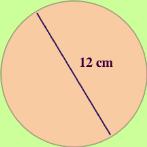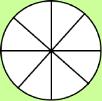 |
||||
©2009–2016 Sherry Skipper Spurgeon. All Rights Reserved. |
||
Finding the area of a circle isn't the easiest thing because a circle is, well, round. But, if you are familiar with finding the area of other polygons, then circles will not be very difficult. Promise! Start by gathering up the following materials: |
||
 |
||||||||||||||||
 |
||||||||||||||||
 |
||||||||||||||||
• circular coffee filter • scissors |
• glue or glue-stick • sheet of paper |
• pencil • calculator |
||||||||||||||
Step 1: Fold the Coffee Filter
|
||
Step 2: Cut the Sectors
|
||||
 |
||||
Step 3: Put the sectors together Gather up all the sectors and on the blank sheet of paper, begin laying the sectors out in puzzle-style, alternating point up, point down, in an AB pattern until all the sectors are used up. You will end up with something that looks like this: |
|||
 |
|||
Step 4: Glue the sectors down
|
||
|
||||
 |
||||
 |
||
So, let's try it with some numbers, shall we? Let's say that we have the following circle. |
|
 |
||||
Here is a circle with diameter of 12 cm. What is its area? Think it through…You know what the area formula is. What information do you have? |
||||
You know the diameter is 12 but you need to have a radius measure. How do you find the radius? Think…ahh! A radius is half of a diameter! Take half of 12 and you get 6. Now, use the Substitution Property and put the 6 in for the r. |
||
 |
||
